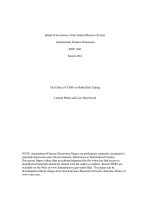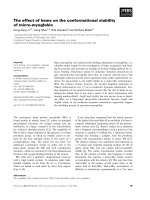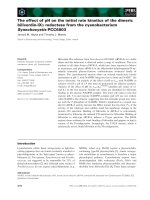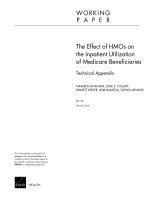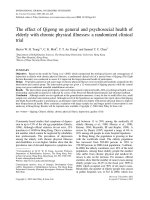The effect of corruption on stock market volatility
Bạn đang xem bản rút gọn của tài liệu. Xem và tải ngay bản đầy đủ của tài liệu tại đây (314.76 KB, 7 trang )
Journal of Applied Finance & Banking, vol. 10, no. 2, 2020, 117-123
ISSN: 1792-6580 (print version), 1792-6599(online)
Scientific Press International Limited
The effect of corruption on stock market volatility
Eleftherios Spyromitros1
Abstract
This paper addresses the issue of impacts of corruption on stock market volatility.
By applying panel data analysis on a set of 16 countries from 2010 to 2016,
sufficient evidence for a negative relationship between corruption and stock market
volatility is provided, while controlling for several macroeconomic and financial
variables.
JEL classification numbers: D73, E44, G1.
Keywords: Corruption, stock market volatility, panel data.
1. Introduction
The role of corruption in affecting economic growth has been extensively
investigated by the existing literature providing mixed results. The seminal study
by Mauro (1995) shows a negative effect of corruption on growth through its impact
on investment. Méon and Sekkat (2005) argue that corruption may have a different
impact on growth depending upon the quality of governing institutions. Precisely,
they show that, under low quality governing institutions, growth lowers more. In
the same context, the embezzlement of tax revenues by public officials leads the
government to rely more on seigniorage to cover its expenditures raising thus
inflationand lowering investment (Blackburn and Powell, 2011).
On the other hand, Aidt et al. (2008) show that low quality of government
institutions is not related to economic growth. Méon and Weill (2010) confirm that
corruption is less damaging in countries where the institutional framework is
ineffective. Moreover, the role of economic freedom in modifying the impact of
corruption on growth is investigated by Swaleheen and Stansel (2007) and
Heckelman and Powell (2010). It is shown that higher (lower) economic freedom is
1
Department of Economics, Democritus University of Thrace.
Article Info: Received: October 7, 2019. Revised: October 22, 2019.
Published online: March 1, 2020.
118
Eleftherios Spyromitros
associated with a positive (negative) effect of corruption on growth. Thus, it appears
that an efficient corruption level that helps overcome the existing institutional
insufficiencies may exist.
From the above, it is unclear whether corruption is detrimental or beneficial for
economic growth. Furthermore, only few studies have focused on the effects of
corruption on the economic performance of firms (Gaviria, 2002). In other words,
bribery may affect the firm's performance either by greasing the wheel of commerce
or by sanding the wheel of commerce. Once again, the results are mixed.
According to Fisman and Svensson (2007) and De Rosa et al. (2010) corruption has
a negative effect on firm growth and productivity, respectively. On the other hand,
Peng and Luo (2000) suggest that connections with government officials can
negatively affect business uncertainty, with a positive impact on firm performance.
Stock markets help companies raise necessary capital from investors, promoting
thus economic growth. However, in the case of volatile stock markets risk-adverse
investors tend to avoid exposure in such markets, negatively affecting investment.
In this context several studies document the effect of political uncertainty and news
on stock market volatility (Mei and Guo, 2004; Önder and Şimga-Mugan, 2006;
Goodell and Vahamaa, 2013; Chau et al., 2014). In this study, we aim to investigate
the role of corruption on stock market volatility.
Several empirical studies have investigated the effect of corruption on financial
markets finding that corruption is harmful for financial markets. Specifically,
Ciocchini et al. (2003) consider bond spread as a proxy for borrowing cost and show
that corruption increase borrowing costs for governments and firms in emerging
markets. Lee and Ng (2009), by examining stock prices, they show that corruption
decreases equity values after controlling for some firm- and country-level control
factors. In this context, Gelos and Wei (2002) find that a lower level of country
transparency discourages investment from international funds. In other words,
corrupted countries is more likely to receive less investment from foreign investors.
The role of the quality of governance is also highlighted by more recent studies.
Hooper et al. (2009) provide evidence that good governance quality is positively
associated with stock returns but, on the other hand, Low et al. (2011) show that
countries with weak governance framework characterized by ineffective
government and lack of control for corruption exhibit higher equity returns than
countries with strong governance settings.
More closely to our study, Pastor and Veronesi (2012) show from their general
equilibrium model that bribery may lower the stock market volatility especially in
emerging markets. In the same spirit, Zhang (2012) uses the corruption perception
index to assess the effect of corruption on stock market volatility in the period 20022007 for 29 stock exchange markets. It is shown that there is a negative correlation
between corruption and stock market volatility, however this result is obtained prior
to the global financial crisis. In our analysis, we consider the period after the
financial crisis.
The effect of corruption on stock market volatility
119
The remainder of the paper is structured as follows: Section 2 presents data and
methodology employed in our empirical analysis. Section 3 presents and discusses
the main results and finally section 4 concludes.
2. Data and Methodology
We collect data from 2010 to 2016 on the following countries: Australia, Brazil,
Canada, Chile, China, Denmark, India, Japan, Korea, Norway, Russia, South Africa,
Sweden, Switzerland, United Kingdom, and the United States. The dependent
variable is annual stock returns’ volatility (VOL). To measure it, we collect monthly
data from the OECD database. For the VOL, we use the season adjusted approach,
which is commonly used in the literature. This is the standard deviation of the
monthly returns, multiplied with the square-root of 12 (as it is monthly) and with
100 to turn it into a percentage.
This can be described as:
𝑉𝑂𝐿 = 𝑆𝑡. 𝑑𝑒𝑣(𝑚𝑟𝑒𝑡𝑢𝑟𝑛𝑠 ) ∗ √12 ∗ 100
The independent variables used in the regressions are: the corruption perception
index (CPI) published by Transparency International, GDP growth (GDPg),
inflation (CPI), one-year money market interest rates (IR), and finally economic
openness of a country defined as the percentage of the total trade over GDP (OPN).
For GDPg, we use the data collected from the OECD database. CPI, OPN and IR
data2 are drawn from the World Bank database.
The basic model for estimating the relation between stock returns’ volatility and the
independent variables is:
𝑉𝑂𝐿𝑖𝑡 = 𝛽1 𝐶𝑂𝑅𝑖𝑡 + 𝛽2 𝐺𝐷𝑃𝑔𝑖𝑡 + 𝛽3 𝐶𝑃𝐼𝑖𝑡 + 𝛽4 𝐼𝑅𝑖𝑡 + 𝛽5 𝑂𝑃𝑁𝑖𝑡 + 𝜇𝑖 + 𝑢𝑖𝑡 .
where the last two terms are the individual heterogeneity term (𝜇𝑖 ) and the common
error term (𝑢𝑖𝑡 ). To continue with the regressions, we test for the unit roots at the
variables. Then, to estimate the results, we apply a panel regression analysis with
variations according to the results of the diagnostic tests. The four basic variations
used here are as follows: the fixed effects and the random effects regression; the
Prais–Winsten panel corrected standard error regression which is a linear regression
used for autocorrelated panels with corrected standard errors to avoid the violation
of ordinary least square (OLS) estimators and the Driscoll–Kraay standard error
regression (Driscoll and Kraay, 1998), which is a pooled OLS regression. To
determine the results, we consider the fixed effects and the random effects
2
In the case of Denmark, Switzerland and Sweden, we use the one-year EURIBOR rate, which is
the one commonly used in these countries. For the United Kingdom, we use the one-year LIBOR
rate. Both EURIBOR and LIBOR are drafted from their official website, in which each rate is quoted.
To annualize the rates, we use the mean value of the rates quoted in each year.
120
Eleftherios Spyromitros
regression through the Hausman test. For both cases, we also apply the crosssectional dependence tests of Frees and Pesaran (Frees, 1995; Pesaran, 2004).
Moreover, the Wooldridge test for autocorrelation is conducted (Wooldridge, 2002).
We also consider a Breusch and Pagan LM test to decide between random effects
and a simple OLS model (Breusch and Pagan, 1980).
3. Empirical Results
In Table 1, we use Harris-Tzavalis test to examine non-stationarity of our variables
of interest. We observe that only OPN and IR have a unit root. To correct this issue,
we take first differences.
Table 1. Unit-root tests for dataset including all countries
Variable/ Test Name
VOL
Harris-Tzavalis
-0.0394***
(0.0000)
COR
0.4541**
(0.0000)
GDPg
0.2054***
(0.0000)
CPI
0.2531***
(0.0000)
IR
0.5064
(0.1014)
OPN
0.7106
(0.8211)
d. IR
-0.0153***
(0.0000)
d. OPN
-0.0717***
(0.0000)
Note: Ho, unit root is present. P-values are in parentheses. *,** and
***indicate statistical significance at the 10%, 5%, and 1% level, respectively.
Table 2 presents the results of the regressions for the annual volatility of the stock
indexes for the whole country dataset. According to the Hausman test, the random
effects regression is recommended. The Wooldridge test for autocorrelation
suggests no autocorrelation, while Frees and Pesaran tests show cross sectional
dependence in our residuals. Therefore, we continue the regression with a linear
regression with the Prais–Winsten panel-corrected standard errors specification, as
well as we test the results with a Driscoll-Kraay corrected standard errors regression.
Corruption, and openness have a statistically significant effect on volatility, and all
the other variables are statistically insignificant.
The effect of corruption on stock market volatility
121
Table 2. Panel data estimation results for stock market volatility
VOL
Random Effects Prais-Winsten Driscoll-Kraay
COR
-.0011**
-.0011**
-.0.011*
(0.017)
(0.016)
(0.057)
GDPG
.00094
.0006
.0006
(0.451)
(0.7)
(0.708)
CPI
.0028
-.0034
-.0034
(0.960)
(0.244)
(0.285)
d. IR
.0007***
.0026*
-.0004
(0.000)
(0.862)
(0.781)
d. OPN
.0026***
.0003*
.0026***
(0.000)
(0.06)
(0.000)
Constant
0.2111***
0.2156***
17.35847***
(0.000)
(0.000)
(0.000)
2
0.1172
0.1188
0.1062
𝑅
Hausman Test (FEM vs REM)
𝑥 2 (5)=1.41
(0.9236)
Test of cross-sectional
0.194
independence by Frees
α=0.4127
Test of cross-sectional
3.382
independence by Pesaran
(0.0007)
Test for autocorrelation by
F(1,15)=0.001
Wooldridge
(0.9814)
2
Breusch-Pagan LM Test for
𝑥̅ (01)=7.54
REM vs OLS
(0.003)
Note: *,** and *** indicate statistical significance at the 10%, 5%, and 1% level,
respectively.
In effect, we confirm the results obtained by Zhang (2012) for the post crisis period
under investigation. The negative relationship between corruption and stock
market volatility is statistically significant when controlling for a number of
macroeconomic and financial variables. It appears that corruption may not be
harmful for financial stability. Moreover, the positive link between trade openness
and stock market volatility can be explained on the ground that the exposure of
listed firms on international trade and adverse shocks is important because of more
international risk sharing between markets and thus any related issues are
transmitted in the stock markets affecting thus their volatility.
122
Eleftherios Spyromitros
4. Conclusion
This paper addresses the effect of corruption, measured by the corruption perception
index, on stock market volatility. By applying panel data analysis on a set of 16
countries from 2010 to 2016 and considering the main macroeconomic variables as
control variables, sufficient evidence for a negative relationship is provided.
Therefore, corruption may have a different than expected effect on stock market
volatility, implying benefits for financial stability. However, this result should be
interpreted with caution due to the fact that the index of corruption is based on
perception rather than experience.
References
[1] Aidt, T. S., J. Dutta, and V. Sena. (2008). Governance Regimes, Corruption
and Growth: Theory and Evidence. Journal of Comparative Economics, 36 (1),
195-220.
[2] Breusch, T. S., and Pagan, A. R. (1980). The Lagrange multiplier test and its
applications to model specification in econometrics. The Review of Economic
Studies, 47(1), 239-253.
[3] Ciocchini, F., Durbin, E., and Ng, D.T.C. (2003). Does corruption increase
emerging market bond spreads? Journal of Economics and Business, 55, 503528.
[4] Chau, F., Deesomsak, R., and Wang, J. (2014). Political uncertainty and stock
market volatility in the Middle East and North African (MENA) countries.
Journal of International Financial Markets, Institutions and Money, 28, 1-19.
[5] De Rosa, D., Gooroochurn, N., and Gorg, H. (2010). Corruption and
productivity: firm-level evidence from the BEEPS survey. The World Bank
Working Paper Series, WPS5348.
[6] Driscoll, J. C., and Kraay, A. C. (1998). Consistent covariance matrix
estimation with spatially dependent panel data. Review of Economics and
Statistics, 80(4), 549-560.
[7] Frees, E.W. (1995). Assessing cross-sectional correlations in panel data.
Journal of Econometrics, 69, 393–414.
[8] Gaviria, A. (2002). Assessing the effects of corruption and crime on firm
performance: evidence from Latin America. Emerging Market Review, 3, 245268.
[9] Gelos, R. G., and Wei, S. J. (2002). Transparency and international investor
behavior. National Bureau of Economic Research (No. w9260).
[10] Goodell, J.W., and Vahamaa, S. (2013). US presidential elections and implied
volatility: the role of political uncertainty. Journal of Banking & Finance, 37,
1108–1117.
[11] Heckelman, J.C. and Powell, B. (2010). Corruption and the Institutional
Environment for Growth. Comparative Economic Studies, 52(3), 351-378.
[12] Hooper, V., Sim, A. B., and Uppal, A. (2009). Governance and stock market
performance. Economic Systems, 33(2), 93-116.
The effect of corruption on stock market volatility
123
[13] Lee, C. M., & Ng, D. (2009). Corruption and international valuation: does
virtue pay?. The Journal of Investing, 18(4), 23-41.
[14] Leff, N.H. (1964). Economic development through bureaucratic corruption.
American Behavioral Scientist, 8(3), 8–14. Reprinted in A. J. Heidenheimer,
M. Johnston and V. T. LeVine (eds.), Political Corruption: A Handbook (New
Brunswick: Transaction Publishers, 1989), 389–403.
[15] Low, S.-W., Kew, S.-R., and Tee, L.-T. (2011). International Evidence on the
Link between Quality of Governance and Stock Market Performance. Global
Economic Review, 40(3), 361-384.
[16] Mauro, P., 1995. Corruption and growth. Quarterly Journal of Economics, 110
(3), 681-712.
[17] Mei, J., and Guo, L. (2004). Political uncertainty, financial crisis and market
volatility. European Financial Management, 10(4), 639-657.
[18] Méon, P.-G., and Sekkat, K. (2005). Does corruption grease or sand the wheels
of growth? Public Choice, 122 (1–2), 69-97.
[19] Méon, P-G. and Weill, L. (2010). Is Corruption an Efficient Grease? World
Development, 38(3), 244-259.
[20] Önder, Z., and Şimga-Mugan, C. (2006). How do political and economic news
affect emerging markets? Evidence from Argentina and Turkey. Emerging
Markets Finance and Trade, 42(4), 50-77.
[21] Pastor, L., and Veronesi, P. (2012). Uncertainty about government policy and
stock prices. The Journal of Finance, 67(4), 1219-1264.
[22] Peng, M.W., and Luo, Y. (2000). Managerial ties and firm performance in a
transition economy: the nature of a micro–macro link. The Academy of
Management Journal 43, 486-501.
[23] Pesaran, M. H. (2004). General diagnostic tests for cross section dependence
in panels. University of Cambridge, Faculty of Economics, Cambridge
Working Papers in Economics No. 0435.
[24] Rogoff, K. (1985). The optimal degree of commitment to a monetary target.
Quarterly Journal of Economics, 100(4), 1169-1190.
[25] Swaleheen, M., and Stansel, D. (2007). Economic freedom, corruption, and
growth. Cato Journal, 27(3), 18-25.
[26] Wooldridge, J. M. (2002). Econometric Analysis of Cross Section and Panel
Data. Cambridge, MA: MIT Press.
[27] Zhang, A. (2012). An examination of the effects of corruption on financial
market volatility. Journal of Emerging Market Finance, 11, 301-322.


